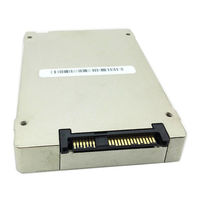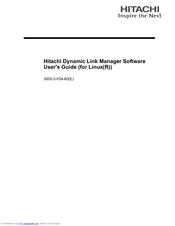User Manuals: Hitachi Dynamic Link Manager Storage
Manuals and User Guides for Hitachi Dynamic Link Manager Storage. We have 6 Hitachi Dynamic Link Manager Storage manuals available for free PDF download: User Manual
Hitachi Dynamic Link Manager User Manual (640 pages)
Command Suite for Linux(R)
Table of Contents
-
Preface13
-
Getting Help18
-
Comments18
-
-
What Is HDLM20
-
-
-
-
-
Installing HDLM143
-
Setting up Xen154
-
-
Disk173
-
Settings for Xen243
-
Settings for KVM245
-
Settings for VCS251
-
Setting up HDLM252
-
Advertisement
Hitachi Dynamic Link Manager User Manual (746 pages)
Hitachi Dynamic Link Manager Software User's Guide for Linux (6.x) (HIT5203-96004, October 2011)
Table of Contents
-
-
-
What Is HDLM26
-
-
-
-
-
Installing HDLM163
-
-
Settings for Xen282
-
Settings for KVM284
-
Settings for VCS292
-
Setting up HDLM295
-
-
-
4 HDLM Operation
353-
-
-
Device, and LDEV368
-
-
Hitachi Dynamic Link Manager User Manual (574 pages)
Hitachi Dynamic Link Manager Software User Guide for Solaris (6.6) (HIT5205-96011, November 2011)
Table of Contents
-
Preface13
-
Getting Help18
-
Comments18
-
-
What Is HDLM20
-
-
-
-
-
Installing HDLM105
-
-
Set up VXVM110
-
-
-
-
-
Precautions165
-
-
-
-
Setting up VXVM200
-
Setting up SDS220
-
Setting up SVM224
-
Notes224
-
-
Setting up VCS227
-
-
-
SDS Settings242
-
SVM Settings242
-
VXVM Settings242
-
Advertisement
Hitachi Dynamic Link Manager User Manual (450 pages)
Hitachi Dynamic Link Manager Software User Guide for AIX (6.6) (T5208-96012, November 2011)
Table of Contents
-
Preface11
-
Getting Help16
-
Comments16
-
-
What Is HDLM18
-
-
-
Parameters23
-
-
-
-
-
-
-
Setting up HDLM130
-
-
-
Hitachi Dynamic Link Manager User Manual (422 pages)
Hitachi Dynamic Link Manager Software User Guide for Windows (6.6) (HIT5201-96006, November 2011)
Table of Contents
-
Preface11
-
Getting Help16
-
Comments16
-
-
What Is HDLM18
-
-
-
-
-
-
Installing JRE131
-
Setting up HDLM134
-
-
Hitachi Dynamic Link Manager User Manual (188 pages)
Command Suite for VMware(R)
Table of Contents
-
Getting Help13
-
-
What Is Hdlm16
-
-
-
Advertisement





